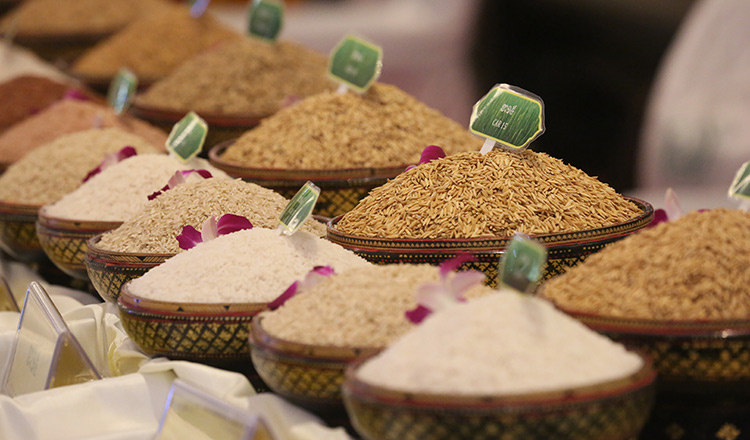Rice, often referred to as the “staff of life,” holds a special place in Cambodian culture and cuisine. As the cornerstone of many traditional dishes and a symbol of sustenance, unity, and prosperity, Cambodian rice is deeply intertwined with the nation’s identity. In this article, we delve into the rich tapestry of Cambodian rice – its diverse varieties, meticulous preparation, and profound cultural significance.
Varieties of Cambodian Rice: A Kaleidoscope of Flavors and Colors
Cambodia boasts a remarkable array of rice varieties, each possessing its own distinct attributes, flavors, and uses. The most revered variety is the fragrant Jasmine rice, known locally as “Phka Malis.” Its subtle aroma and delicate taste make it a staple for celebratory feasts and everyday meals alike.
Beyond Jasmine rice, Cambodia is home to an assortment of colored rice varieties. The deep black hues of Black Jasmine rice and the reddish tones of Red Jasmine rice add a visual feast to the dining experience. These colored rice varieties not only provide a visual contrast but also offer unique flavors that harmonize with a myriad of traditional Cambodian dishes.

Cambodian Rice By Khmer Times
From Field to Plate: The Journey of Cambodian Rice
The journey of Cambodian rice from the paddy field to the dining table is a testament to the dedication and hard work of farmers across the country. The cultivation of rice is a labor-intensive process, from the planting of seeds to the nurturing of young plants in flooded fields. As the plants mature, the fields transform into breathtaking landscapes of swaying golden grains, creating a natural spectacle that symbolizes abundance.
Harvesting rice is a communal affair in Cambodia. Families and neighbors gather to help each other bring in the harvest, fostering a sense of unity and cooperation within rural communities. Once harvested, the rice undergoes threshing and milling to transform it into familiar grains that find their way into kitchens across the nation.
Cultural Significance of Cambodian Rice
Rice is more than just a staple food; it is deeply embedded in Cambodian culture and spirituality. The act of planting and harvesting rice is often accompanied by ceremonies and rituals that pay homage to ancestral spirits and deities believed to protect the crops. During festivals and special occasions, offerings of rice are made to the spirits as a gesture of gratitude and respect.
Rice is also a symbol of hospitality in Cambodia. When welcoming guests into their homes, Cambodians traditionally offer a bowl of rice, reflecting the importance of sharing and community in their culture.
Rice and Culinary Delights: Traditional Cambodian Dishes
Cambodian cuisine showcases the versatility of rice through an array of traditional dishes. From the iconic “Amok” – a dish featuring fish or other proteins cooked in a fragrant coconut curry – to “Bai Sach Chrouk” – a breakfast favorite of pork and rice – Cambodian recipes highlight the harmonious blend of flavors and textures that rice can offer.
Desserts, too, find inspiration in rice. “Num Ansom Chek,” a sweet treat made from glutinous rice, coconut milk, and bananas, provides a delightful end to a meal.
You may check:Best Cambodian Foods You Must Try
List of The Best Cambodian Rice Types
Cambodia is known for its rich variety of rice, with many different types cultivated and consumed throughout the country. The exact number of rice varieties can be quite extensive, as local communities often have their own unique strains. However, I can provide you with a general overview of some of the main types of rice commonly found in Cambodia:
- Jasmine Rice (Phka Malis): This fragrant, long-grain rice is one of the most popular varieties in Cambodia and is often used for special occasions and traditional dishes.
- Sen Kra Ob: A fragrant rice variety with a slightly sticky texture, often used in savory dishes.
- Sen Pidao: Another fragrant rice with a sticky texture, often used for making traditional Cambodian desserts.
- IR 66: A common type of rice known for its resistance to pests and diseases, making it a staple for many farmers.
- IR 64: A widely cultivated rice variety known for its good yield and versatility in cooking.
- Phka Romeat: This variety is valued for its red bran and nutty flavor, often used in traditional dishes for its color and unique taste.
- White Rice: While not a specific variety, plain white rice is a staple in Cambodian cuisine, often served with a variety of dishes.
- Glutinous Rice (Sticky Rice): Used for both savory and sweet dishes, sticky rice is an important component of Cambodian cuisine.
- Black Jasmine Rice: Known for its distinctive black color, this type of rice is often used in both traditional and contemporary dishes.
- Red Jasmine Rice: Similar to black jasmine rice, this variety has a reddish hue and is used for its color and flavor.
- Purple Rice: Another colorful variety of rice, purple rice is used in both savory and sweet dishes.
- New Rice (Angkor Srov Thmey): This refers to newly harvested rice that is tender and has a unique taste. It is often enjoyed during the rice harvest season.
These are just a few examples of the rice varieties found in Cambodia. The country’s diverse landscape, climate, and culinary traditions contribute to the wide array of rice types that are cultivated and cherished in Cambodian cuisine.
How Cambodia Produces One of the World’s Best Rice
In recent years, Cambodia has emerged as a global contender in rice production, earning recognition for producing some of the finest grains on the planet. This meteoric rise from a turbulent past to a rice-producing powerhouse is a testament to the country’s dedication to agricultural advancement, sustainable practices, and innovation. Let’s delve into the factors that have propelled Cambodia to produce arguably the world’s best rice.
Resilience and Recovery
Cambodia’s journey to rice excellence is intertwined with its recovery from the devastating Khmer Rouge regime. After decades of conflict and instability, the nation recognized the need to rebuild its agricultural sector to ensure food security. This commitment laid the groundwork for advancements that would eventually propel Cambodia to global recognition in rice production.
Diverse Rice Varieties
Cambodia’s rich biodiversity is a key factor behind its success. The country boasts a variety of rice strains, each with distinct characteristics and flavors. From the fragrant Jasmine rice to the nutty flavors of red and black rice varieties, Cambodia’s diverse rice palette has contributed to its reputation for producing high-quality grains that cater to different culinary preferences.
Sustainable Farming Practices
The adoption of sustainable farming practices has played a crucial role in Cambodia’s rice success story. Traditional rice farming techniques, such as the SRI (System of Rice Intensification), emphasize the efficient use of water, organic fertilizers, and spacing between plants. These methods have not only increased yields but also minimized environmental impact, making Cambodian rice an exemplar of sustainable agriculture.
Investment in Infrastructure
To bolster rice production, Cambodia has invested significantly in irrigation infrastructure. The development of irrigation systems has enabled farmers to cultivate rice year-round, reducing vulnerability to climate fluctuations and ensuring consistent harvests. This strategic investment has been pivotal in positioning Cambodia as a reliable source of high-quality rice.
Innovation and Modernization
Cambodia’s commitment to modernization has extended to its rice industry. The adoption of modern technologies, including mechanized farming equipment and improved post-harvest processing, has enhanced efficiency and quality control. Furthermore, the government’s support for research and development in rice cultivation has led to the creation of disease-resistant and higher-yielding rice varieties.
International Recognition
Cambodia’s efforts have not gone unnoticed. In recent years, Cambodian rice has garnered international acclaim, earning prestigious awards and recognition for its taste, texture, and appearance. These accolades have propelled Cambodian rice onto the world stage, fostering a global demand for its premium grains.
Trade Partnerships and Export Success
Cambodia’s ability to establish trade partnerships has further bolstered its rice industry. The country’s rice exports have steadily grown, with key markets including Europe, China, and other Asian countries. Cambodia’s reputation for producing high-quality rice has paved the way for lucrative trade agreements that benefit both local farmers and the national economy.
Final Thought
Cambodian rice is more than a mere ingredient; it is a cultural touchstone that binds communities and flavors their traditions. From the fields where it is painstakingly cultivated to the kitchens where it is transformed into delectable dishes, Cambodian rice embodies the nation’s rich history, resilience, and commitment to preserving its culinary heritage. As Cambodian cuisine continues to evolve, the significance of rice remains unwavering – a testament to the enduring heart of Cambodian culture.



